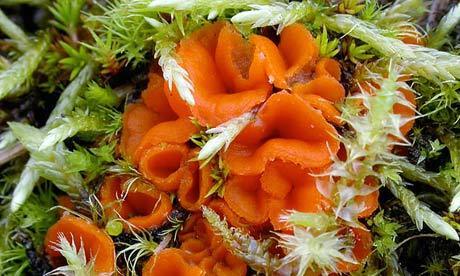A Fungus Named Hotlips
A few weeks ago, sponsored by The Guardian in the UK, which invites readers to give colorful "common" names to species only known by their scientific names. So now . A few of them seem a bit tinselly to me. And some of the entrants need a little help with their own online names: Let's just pass over trancegemeni, greenmeeny, and chatteringmonkey, and gag for a moment over the name Haggissouvlaki, which suggests someone has taken fusion cuisine a frying pan too far.
But never mind. Take a look at a photo of the overall winner in the contest, and you will agree that Hotlips certainly fits:

A lurid orange fungus, previously only known by its forgettable scientific name, Octospora humosa, was dubbed 'hotlips' by Rachael Blackman from Swindon. (Photograph: Thomas Læssøe/MycoKey/Natural England)
The judges explained: "'Hot' is a good description of its red-orange colour and this fungus often grows in tightly packed groups, causing them to curl together into shapes that closely resemble pairs of lips (and even when they are solitary they are disc-shaped with a lip around the edge). This species is also from a group of fungi called discomycetes or "discos" for short, and we loved the notion of a "hotlips disco."
The name came from 12-year-old Rachael Blackman.
Here are the nine other winners:
Chrysis fulgida

Winner
Shimmering ruby-tail – O. Holland
Runner-up
Sapphire-headed ruby wasp – loanna1301
Judges' comments: Chrysis fulgida is one of the most brightly coloured of all our wasps, and this name beautifully describes its metallic appearance in sunlight when it really can seem to "shimmer".
Chrysotoxum elegans

Winner Zipper-back – haggissouvlaki
Runner-up Elegant hover fly – Adriana Muga Forester
Judges' comments: Many hoverflies are harmless mimics of honeybees, bumblebees or, as in the case of Chrysotoxum elegans, wasps. This name cleverly depicts the discontinuous, zipper-like bands across the abdomen of this fly, instead of the continuous bands of common wasps. 'Zipper-back' is just the kind of fun, descriptive name that should get adults and children alike looking more closely at these garden visitors.
Xerocomus bubalinus

Winner Ascot hat – Pixcel
Runner-up Linden rose bollette – PhilLamb
Judges' comments: This species has only been discovered in the UK recently, and the name "Ascot hat" provides the link to the place where it was first found (in Ascot) and reminds us of its hat-like shape. Of course many people also think of hats when they think of Ascot, and we liked this clever double meaning.
Lichenomphalia alpina

Winner Sunburst lichen – Halina Pasiecznik
Runner-up Boggart's blanket – Trancegemini
Judges' comments: This lichen lives in peaty areas and looks just like a tiny burst of sunshine against the dark soil, so the name fits it perfectly.
Phallusia mammillata

Winner Neptune's heart sea squirt – greenmeeny
Runner-up Opal sea squirt – Pixcel
Judges' comments: This sea squirt is shaped very like a human heart, pumping sea water in through one siphon and out through another. As the largest of all the UK's sea squirts, it seemed appropriate to name Phallusia mammillata after Neptune, the Roman god of the sea. We did wonder if it mattered that the species is a milky white instead of red, but we decided the heart of a sea god might be any colour.
Coryphella browni

Winner Scarlet lady – TheJudderman
Runner-up Sting wraith – dandav
Judges' comments:
This species is certainly scarlet and, since it is a hermaphrodite (in other words, each individual contains male and female sexual organs) the "lady"
label is apt. But what we liked most is that "scarlet lady" implies something very beautiful but with a bit of a darker side, and this gorgeous sea slug certainly has a hidden sting: for its own protection, it recycles the stings from the jelly fish on which it preys.
Sagartiogeton lacerates

Winner Fountain anemone – Martin Cox
Runner-up Sneezing carrot – moregan
Judges' comments: This anemone has delicate translucent tentacles on the end of a more solid stalk, making it just like a fountain. The name suited it perfectly.
Ophiura albida

Winner Serpents' table brittle star – Kmnaut
Runner-up Twin-spot brittlestar – culbin
Judges' comments:
This suggestion struck us as particularly ingenious. This species can be distinguished from all other brittle stars by the paired spots at the base of
each of its snake-like arms, giving the appearance of five snakes resting their heads on a table – the spots are like the snakes' eyes. This name is both memorable and helps you identify the species, in other words just what we were looking for in a name.
Nymphon gracile

Winner Gangly lancer – TheAlnOwl
Runner-up Lowry's sea spider – chatteringmonkey
Judges' comments: This name made us laugh and brilliantly captured both this sea spider's gangly nature and its large fang-like structures (actually called "chelifores") at the front of its head.











